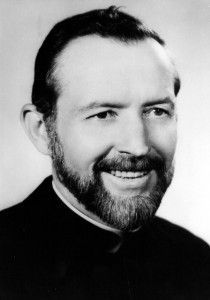Stanley Rother (Stanley Francis Rother)

Stanley Rother was born on March 27, 1935, the son of Franz and Gertrude Rother, who had a farm near Okarche, Oklahoma. He grew up to be a strong, young man, adept at the many tasks required on the farm. Nonetheless, after completing high school, he declared his calling to the priesthood. To prepare for this, he was sent to Assumption Seminary in San Antonio, Texas. His talents gained working on the farm, however, left him with so many duties at the seminary that his studies suffered. After nearly six years, the seminary staff advised him to withdraw. After consultion with his bishop, Victor Reed, Rother then attended Mount St. Mary’s Seminary in Emmitsburg, Maryland, from which he graduated in 1963. He was ordained by Reed as a priest of the Diocese of Oklahoma City-Tulsa (now the Archdiocese of Oklahoma City) on May 25 of that same year. Rother then served as an associate pastor in various parishes around Oklahoma. In 1968, at his own request, he was assigned to the mission of the archdiocese to the Tz’utujil people located in Santiago Atitlán, in the rural highlands of southwest Guatemala.
So that he could be in close touch with his people, Stanley Rother set to work to learn Spanish and then the indigenous Tzutuhil language, an unwritten, language until an earlier missionary, Ramón Carlín, had set about putting it into written form. Rother went to live with a native family for a while to get a better grasp of practical conversation. After Carlin’s death, he continued working on a translation of the gospels into that language. He worked with the people to show them how to read and write. He supported a radio station located on the mission property which transmitted daily lessons in language and mathematics. He served in Santiago Atitlán for 13 years. During that time, in addition to his pastoral duties, he translated the New Testament into Tz’utujil and began the regular celebration of the Mass in that same tongue.
Stanley Rother also founded a small hospital to serve the community, which was located in Panabaj. The “Hospitalito” and the whole neighborhood of Panabaj were buried in the mudslides that followed Hurricane Stan in October 2005. While residing in a temporary building, construction of a permanent facility began on November 10, 2008 (Approx. 15°38’59.40″N 91°13’30.61″W). The “Hospitalito” re-opened during the dedication of the first floor on November 19, 2010, and now plays a vital role in the healthcare of the Lake Atitlán community. Within the last year of his life, Rother saw the radio station smashed and its director murdered. His catechists and parishioners would disappear and later be found dead, their bodies showing signs of having been beaten and tortured. Rother knew all this when he returned to Guatemala in May 1981. In early 1981 Stanley Rother was warned that his name was on a death list and that he should leave Guatemala. He returned to Oklahoma in January 1981, but asked for permission to return. Rother went back to Santiago Atitlán in April. On the morning of July 28, gunmen broke into the rectory of his church and shot him twice in the head after a brief struggle. The killers forced a gardener to lead them to the bedroom of the “red-bearded Oklahoma-born missionary”. He was one of 10 priests murdered in Guatemala that year.
Born
- March, 27, 1935
- USA
- Okarche, Oklahoma
Died
- July, 28, 1981
- Guatemala
- Santiago Atitlan, Sololá
Cause of Death
- gunshot wounds
Cemetery
- Okarche, Oklahoma
- USA


